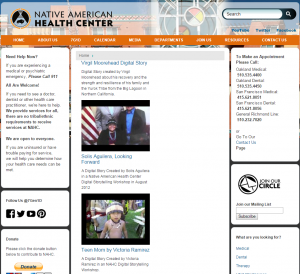After the first few readings of this course, my interest has been peaked by the use of digital storytelling that is created by or with indigenous peoples for indigenous communities. Ginsburg (2002) discusses the potential that media such as satellite television transmissions have to indigenous communities in terms of offering a means of “cultural preservation and production and a form of political mobilization” (p. 54) and I’d like to explore the impact of the medium of digital storytelling.
I’ve found the following resources to be a great starting point for this focus. I’m not sure at the moment how I will narrow my focus down, but I’m excited about the possibilities within the realm of digital storytelling!
This project looks at how the residential school legacy is passed on between generations. There are several digital stories told by six women in their own words and their understanding of how residential schools have impacted them and the relationships they have with their mothers.
This article by Iseke and Moore (2011) covers a few projects of indigenous storytelling and discusses the many benefits of indigenous storytelling, including creating opportunities to understand political activism and reflecting cultural mandates of communities. It highlights the importance of indigenous self-representation and “reversing the colonial gaze by constructing their own visual media, telling their stories on their own terms” (p. 32).
I was intrigued by this aspect of storytelling. While different from digital stories, it discusses using videogames as a medium to spread indigenous values and stories. They are also being used to reconnect youth with their heritage and help to maintain it. The video game released is called Never Alone with the hopes that youth would listen, learn and pass down their stories for future generations. Here’s a video clip of the game developers discussing the collaboration between game designers and members of the Cook Inlet Tribal Council on the videogame’s development.
The Yijala Yala Project is based in the Pilbara region of Western Australia and it “seeks to highlight cultural heritage as living, continually evolving and in the here and now, rather than of the past, and works with community members to create content and develop skills that assist in communicating their cultural heritage to a wide audience.” You can see the list of all the videos they’ve created so far here: https://vimeo.com/user5307782
This article discusses a digital storytelling research project at Vancouver Island University where five Aboriginal youth are trained as mentors and research assistants to teach other Aboriginal Youth and Elders how to create their own digital stories about topics they find important. I want to share one quote that stood out to me from one of the research assistants, Gladys Joe: “I hope I can do this kind of work for the rest of my life. Sharing stories and culture through modern technology is beneficial for future generations.”


